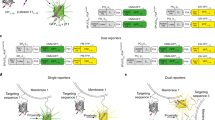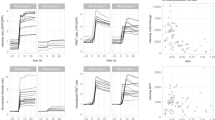Abstract
The investigation of many problems in cell biology requires a method for studying chemical ‘events’ in living cells. For example, the measurement of cytosolic free Ca2+, using Ca2+ indicators in giant cells, has provided vital evidence for the role of this ion in the activation of cells by electrical and chemical stimuli1. However, the incorporation of Ca2+ indicators into small cells (diameter <20 µm), without causing irreversible damage, has proved extremely difficult1. Recently, an elegant new technique has been reported2 for entrapping within small cells a fluorescent Ca2+ indicator after hydrolysis within the cell of a membrane-permeant ester of the compound. We have developed a method, using Sendai virus, for fusing cells with erythrocyte ghosts containing photoprotein Ca2+ indicators and other membrane-impermeant chemiluminescent-labelled indicators3,4. Because of the sensitivity of chemiluminescent analysis, these indicators can be used at concentrations which do not significantly disturb the chemistry of the cells. The ultimate aim was to establish a cell system in which free Ca2+, oxygen radicals and cyclic nucleotides could be directly monitored. Here we report the incorporation of the photoprotein, obelin5, an indicator of free Ca2+, into small mammalian cell hybrids.
This is a preview of subscription content, access via your institution
Access options
Subscribe to this journal
Receive 51 print issues and online access
$199.00 per year
only $3.90 per issue
Buy this article
- Purchase on Springer Link
- Instant access to full article PDF
Prices may be subject to local taxes which are calculated during checkout
Similar content being viewed by others
References
Ashley, C. C. & Campbell, A. K. (eds) Detection and Measurement of Free Ca2+ in Cells (Elsevier, Amsterdam, 1979).
Tsien, R. Y. Nature 290, 527–528 (1981).
Campbell, A. K. & Simpson, J. S. A. Techniques metabolic Res. B213, 1–56 (1979).
Campbell, A. K. et al. J. Physiol., Lond. 306, 3P–4P (1980).
Campbell, A. K. Biochem. J. 143, 411–418 (1974).
Rechsteiner, M. Expl Cell Res. 93, 487–492 (1975).
Hallett, M. B., Luzio, J. P. & Campbell, A. K. Immunology 44, 569–576 (1981).
Klebanoff, S. J. & Clark, R. A. The Neutrophil: Function and Clinical Disorders (North Holland, Amsterdam, 1978).
Peretz, H., Toister, Z., Laster, Y. & Loyter, A. J. Cell Biol. 63, 1–11 (1974).
Knutton, S. & Pasternak, C. A. Trends biochem. Sci. 4, 220–223 (1979).
Hallett, M. B. & Campbell, A. K. Biochem. J. 192, 587–596 (1980).
Campbell, A. K., Daw, R. A., Hallett, M. B. & Luzio, J. P. Biochem. J. 194, 551–560 (1981).
Heumann, R., Schwab, M. & Thoenen, H. Nature 292, 838–840 (1981).
Author information
Authors and Affiliations
Rights and permissions
About this article
Cite this article
Hallett, M., Campbell, A. Measurement of changes in cytoplasmic free Ca2+ in fused cell hybrids. Nature 295, 155–158 (1982). https://doi.org/10.1038/295155a0
Received:
Accepted:
Issue Date:
DOI: https://doi.org/10.1038/295155a0
This article is cited by
-
Monoclonal antibodies demonstrate protection of polymorphonuclear leukocytes against complement attack
Nature (1985)
-
A chemical procedure for loading the calcium indicator acquorin into mammalian working myocardium
Pfl�gers Archiv European Journal of Physiology (1984)
Comments
By submitting a comment you agree to abide by our Terms and Community Guidelines. If you find something abusive or that does not comply with our terms or guidelines please flag it as inappropriate.



